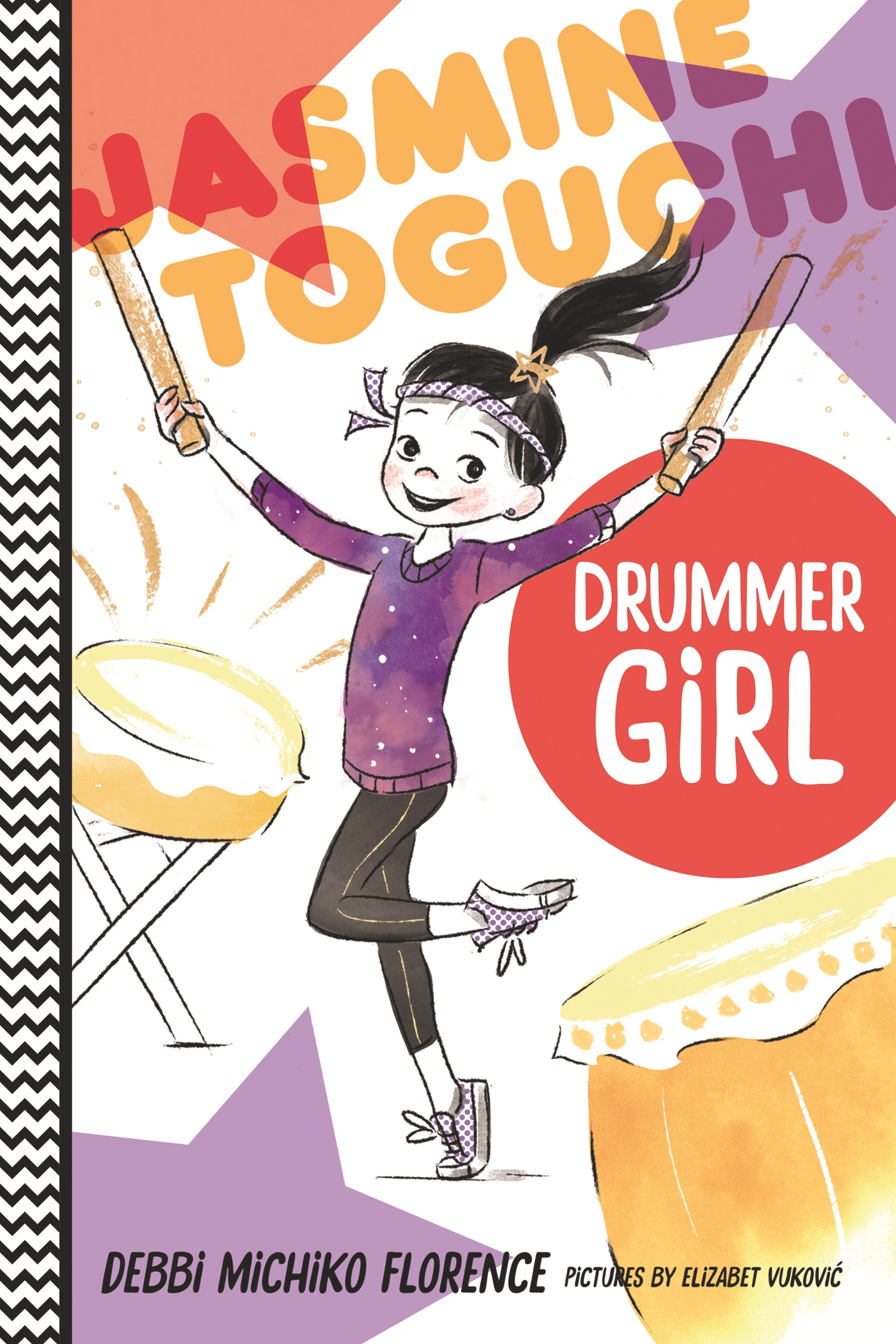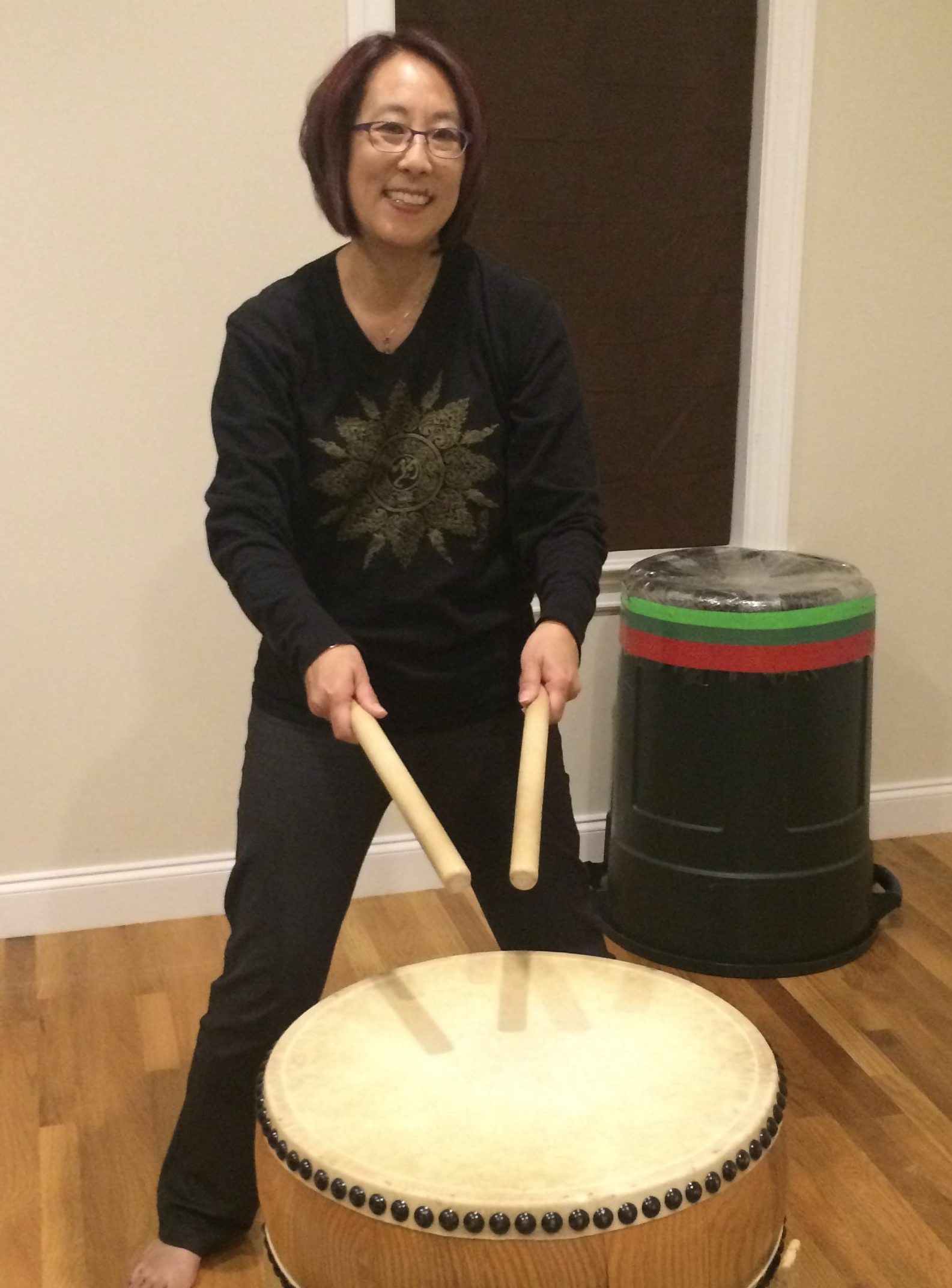
Debbi Michiko Florence: Creating the Drumming Mochi Queen, Jasmine Toguchi
 Debbi Michiko Florence, the author who brought us eight-year-old mochi-loving, flamingo-focused Jasmine Toguchi, was about eight years old herself before she realized eating a side of rice with a plate of spaghetti was not necessarily universal. That experience, which came as part of what Florence describes as growing up both Japanese and American, partially demonstrates why Florence created Jasmine–a girl who could be both a window and a mirror.1 See what Florence had to say about representation and inclusion in children’s books, mochi, and a treat called umeboshi in our interview with her below:
Debbi Michiko Florence, the author who brought us eight-year-old mochi-loving, flamingo-focused Jasmine Toguchi, was about eight years old herself before she realized eating a side of rice with a plate of spaghetti was not necessarily universal. That experience, which came as part of what Florence describes as growing up both Japanese and American, partially demonstrates why Florence created Jasmine–a girl who could be both a window and a mirror.1 See what Florence had to say about representation and inclusion in children’s books, mochi, and a treat called umeboshi in our interview with her below:
Find the Jasmine Toguchi series on the First Book Marketplace:
- Jasmine Toguchi, Mochi Queen (#1)
- Jasmine Toguchi, Super Sleuth (#2)
- Jasmine Toguchi, Drummer Girl (#3)
- Jasmine Toguchi, Flamingo Keeper (#4) (coming in July)
***

First Book: Being an avid reader and a Japanese American, was it obvious to you as a child that you didn’t see characters in books who looked like you? Did this influence your decision to write a series with a Japanese American main character and other characters of diverse backgrounds?
Debbi Michiko Florence: When I was a child, I loved to read. I searched for books with characters who looked like me, but the only books I could find either relied upon stereotypes with stories set in far away places or historical fiction based on events I hadn’t experienced. When I started writing novels, many years ago, I wrote Japanese American or half Japanese American main characters. I never sold those manuscripts, and I suspect it was mostly because I was still learning and growing as a writer. But I did fully recognize that books with Asian American main characters NOT dealing with issues of immigration, assimilation, or culture were not the norm. When I wrote Jasmine Toguchi, Mochi Queen, Jasmine obviously (at least to me) had to be of Japanese heritage. But I very much wanted her to be an American kid, much like I was when I was growing up in Los Angeles. I wanted there to be a balance of Japanese AND American, because that’s how I felt growing up and how I feel today. I’m both.
I searched for books with characters who looked like me, but the only books I could find either relied upon stereotypes with stories set in far away places or historical fiction based on events I hadn’t experienced.
FB: You must have hundreds of funny and/or poignant anecdotes from interactions with your young fans. Can you share one or two with us here?
DMF: I love hearing from readers! After Mochi Queen was released, I heard from a teacher in Wisconsin who told me a story about one of her students who saw the book when the teacher was reading it. The student, who possibly saw herself in Jasmine on the cover, asked to see it, started reading it, and walked away with it. The teacher shared a photo with me of this student sitting in a crowded lunchroom with the book open, engrossed. This student discovered the joy of reading and started reading other books. The student’s mother brought mochi in for the whole classroom. This student wrote me my very first real fan letter (and I cried tears of joy) and I have that letter framed in my office. It reminds me that I write for readers who need to feel heard and understood, to get a glimpse of themselves on the page. I keep hearing stories about kids AND adults who are happy to see themselves in Jasmine’s stories.
At another school, in upstate New York, a librarian read Mochi Queen to her students and then they made mochi (using the recipe at the back of the book). The librarian shared with me the video of the students making and eating mochi. This was a group of predominantly white youngsters who had never made (or eaten) mochi before. It was such fun to hear their comments and watch their faces. One little girl said, “I can’t wait for mochi-tsuki.” Mochi-tsuki means “mochi making” and I was impressed she remembered the phrase from the book. Watching the children try the mochi, even though it might have looked odd to them, and enjoy the mochi, just filled my heart with so much joy!
These two experiences illuminate the need for books that are both mirrors and windows,2 allowing readers to see themselves reflected in a story and to gain empathy and understanding by reading about those who may be different.
I feel so very honored and grateful to be a part of readers’ lives this way.
FB: Besides your own books, what books do you recommend to people who are looking for books featuring diverse characters and/or life experiences? Are there particular authors and/or books which inspired you to become a writer?
DMF: Oh, my goodness! I could go on and on about this topic! It’s hard for me to choose just a few, because there are so many great books out there featuring diverse characters, being written by diverse authors. Authors who inspired me when I started out are Cynthia Leitich Smith, Linda Sue Park, and Lisa Yee. They wrote diverse characters in contemporary settings – Rain is Not My Indian Name, Project Mulberry, and Millicent Min Girl Genius. These books inspired and excited me, and gave me hope.
Currently, some books that I have read and loved along those same lines are The First Rule of Punk by Celia C. Perez, Stef Soto, Taco Queen (available in English and Spanish) by Jennifer Torres, and Jada Jones (chapter book series) by Kelly Starling Lyons for younger readers. For older readers, The Way To Bea by Kat Yeh, Two Naomis by Olugbemisola Rhuday-Perkovich and Audrey Vernick, Flying Lessons edited by Ellen Oh, It’s Not Like It’s A Secret by Misa Sugihara, Want by Cindy Pon, Love Hate and Other Filters by Samira Ahmed, and How It Went Down (available in print and ebook) by Kekla Magoon. I could go on and on. I’m leaving out so many other favorite reads and authors.
FB: Food is such a powerful connector to culture. Can you talk about the significance of the inclusion of mochi as such an important element to your first book the Jasmine Toguchi series? Besides mochi, what are other Japanese foods that you have fond memories of or connections to?
DMF: When I got the idea for Mochi Queen, I was excited to write about a food I loved from my childhood – and still love today. Growing up in Los Angeles, mochi was readily available. It wasn’t until post-publication that I learned how many people did not know what mochi was or had never tasted it, even with mochi ice cream becoming more popular. (By the way, mochi ice cream was invented by a Japanese American woman, Francis Hashimoto, in California in the 1990s.) So, I’m very happy to be spreading the mochi love.
Another Japanese food item that I love is umeboshi – pickled plum. It’s very sour and goes great with rice, but as a child, I ate them on their own. My mom likes to tell a story about when I was very young and we went to visit her aunt in Kabo, on the small island of Oshima. My great aunt was drying umeboshi in the sun outside, and I ran up and grabbed handfuls and stuffed them in my mouth. Perhaps I need to write a story about umeboshi!
I also love Japanese rice. Growing up, I ate rice with almost every meal. Even spaghetti – on my plate would be spaghetti with meat sauce, and next to it, a big scoop of rice. I didn’t know until 3rd grade or so that not everyone ate spaghetti that way.
FB: You have a lot of diverse and unique passions – books, animals, travel. Do you feel your career as a writer allows you to channel so many different passions, and in what ways?
DMF: When I was younger, I had two big passions: animals and books. I feel lucky to have been able to pursue both, first with my degree in zoology, working in raptor rehabilitation and as an educator at a zoo, and now writing books for young people. The travel bug bit me later in life, but I am grateful to be able to travel the world with my husband and daughter. We also lived for a short time in Mexico City and in Shanghai. I do feel like being a writer allows me to channel my many passions, but, even better, I feel like all my experiences feed my writing. Pieces of my life definitely work their way into my stories. When I want to explore more for my works-in-progress, I get to research, which also feeds my passions. For example, for the newest book in the Jasmine Toguchi series, Drummer Girl, I took a taiko lesson so I could get an idea of what Jasmine might experience learning taiko.
Writing books allows me to live many lives through my characters and stories. I think reading books allows the reader to do the same.
FB: I understand that you like to read upper middle grade and young adult novels—is there a reason why you write for younger readers?
DMF: I do write middle grade stories and hope to get those published. It turned out, though, that when I got the spark of an idea for a girl who wants to do the “man’s job” of pounding mochi, that it was definitely for a younger audience. The voice that came to me was of an eight-year-old. I was surprised at how strong Jasmine’s voice was in my head, and how quickly I was taken back to my eight-year-old self. When it comes to writing stories, I rely upon the character to let me know how old they are. I think my inner age is somewhere between 8 – 14.
FB: Do you like flamingos as much as Jasmine does?
DMF: I like flamingos, but I’m not sure anyone loves flamingos as much as Jasmines does!
***
1 Bishop, R. S. (1990). Mirrors, windows, and sliding glass doors. Perspectives, 6(3), ix–xi.
2 ibid
